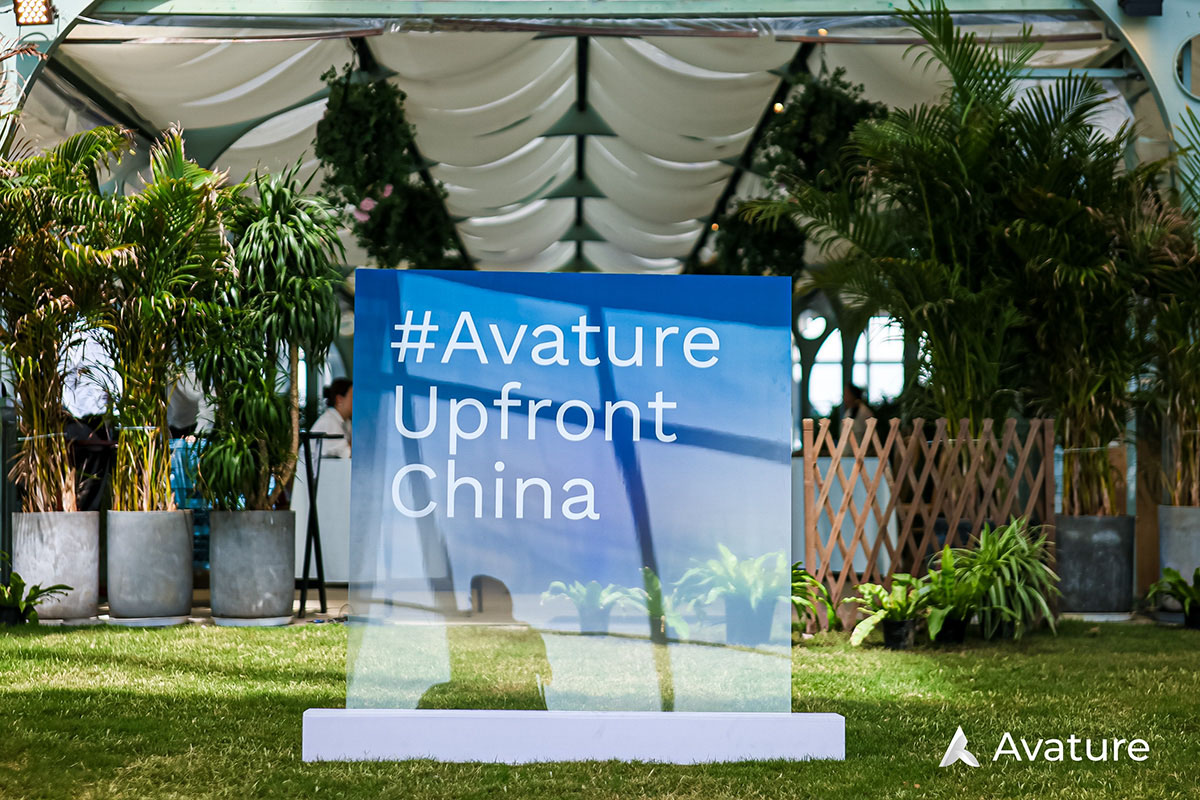
In an era marked by economic instability, rapid technological advancements and dynamic geopolitical shifts, businesses must be agile to swiftly address challenges and seize opportunities. Moreover, organizations must maintain cohesive synergy from strategic planning to execution.
The rise of artificial intelligence, in particular, signifies a profound disruption that is reshaping industry standards, challenging established ways of thinking and compelling companies to reassess their strategic approaches. While AI opens up unprecedented opportunities, it also introduces greater levels of uncertainty and complexity.
#AvatureUpfront China 2025 was designed with these complex realities at its core, bringing together seasoned HR professionals and corporate executives from across industries to share insights and explore strategies for navigating uncertainty and shaping the future collaboratively.
The conference began with remarks from Song Cai, Avature VP Sales, China, who reflected on Avature’s growth and ongoing innovation within the region, and highlighted the organization’s latest developments in AI. He emphasized that Avature is actively fostering the integration of AI technology with HR management scenarios and is dedicated to providing enhanced, dependable technological support to its customers and partners, thereby facilitating business growth and organizational transformation.
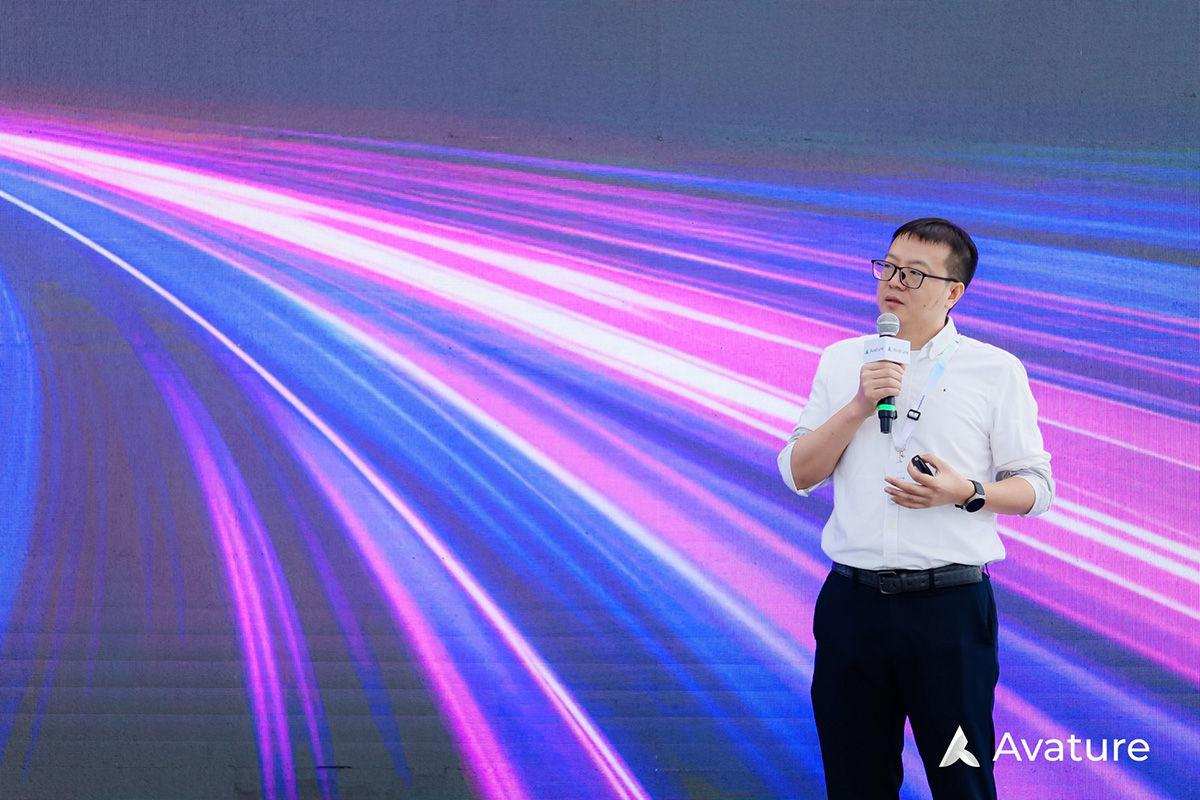
Dual Perspectives in Globalization: Harmonizing Global Outreach and Local Adaptation
As strategies for globalization deepen, striking a balance between a unified brand value proposition and the cultural nuances of local markets has emerged as a pivotal challenge in human resources. This is particularly crucial in the realms of employer branding and localized recruitment tactics, where companies need to craft strategic approaches.
Crafting an Employer Brand That Resonates Globally in the Age of Expansion
At this year’s conference, Shu Hu, Employer Branding Lead at Trip.com Group, returned to the stage to build on her well-received presentations from previous years, focusing on how Trip.com Group continuously crafts a distinctive employer brand under its globalization strategy.
Shu emphasized that truly effective employer branding transcends mere promotional efforts and must incorporate a deep business perspective with actionable capabilities. Confronted with limited resources and a diverse market landscape, Trip.com Group targets three core OKRs: awareness, brand reputation and talent conversion. The company devises tailored content strategies and selects appropriate local communication channels to ensure precise brand delivery and effective conversion.
![Shu Hu from Trip.com Group discusses the ongoing development of a distinctive employer brand in a global context.]](https://www.avature.net/wp-content/uploads/2025/06/Blog-Conference-Recap-China-2025-3.jpg)
Additionally, Trip.com Group champions a data-driven approach: every investment is trackable and accountable, encouraging the team to continuously refine resource allocation and cultivate a more impactful global employer image. Shu notably remarked, “The true value of a brand always stems from actions, not plans. At Trip.com Group, we prioritize rapid initiation and iterative adjustments over perfect plans, effectively tying brand building to long-term business outcomes”.
The essence of our brand’s value lies in actions, not plans. We eschew overly meticulous planning in favor of agile adjustments throughout the implementation process, which forms the crux of our competitive edge.”
Shu Hu
Employer Branding Lead, Trip.com Group
Localized Talent Acquisition Practices: Building L’Oréal China’s ATS
Beyond global strategies, successful localization is crucial. Sara Yu, Sr. TA Operations Manager for North Asia and China at L’Oréal, shared insights into the development of the organization’s localized Applicant Tracking System (ATS) in the Chinese market.
Sara highlighted that L’Oréal has been deeply embedded in the Chinese market for 28 years, always driven by the mission to “create beauty for China.” As a vital region within L’Oréal’s global operations, the Chinese market holds a strategic position. However, the globally unified ATS previously used did not align well with local business needs and candidate experiences, with only about 18 percent of new hires being processed through the system.
This misalignment not only skewed decision-making but also complicated the recruitment process for both the team and candidates. Consequently, developing an ATS that genuinely fits Chinese market demands and local operational contexts became a priority for L’Oréal’s team.
L’Oréal initiated the ATS project with Avature in December 2023, and the customized local ATS was successfully launched in May 2024. This was followed by the rollout of a localized retail recruitment platform in November 2024, which integrated with local business operations and effectively balanced global standards and local requirements.
![Sara Yu discusses the rollout of a localized Applicant Tracking System tailored for the Chinese market at L'Oréal.]](https://www.avature.net/wp-content/uploads/2025/06/Blog-Conference-Recap-China-2025-4-1.jpg)
Reflecting on the project’s success, Sara attributed it to “perfect timing, the right location and the right team.” Favorable policy environments combined with the strategic importance of the Chinese market, supported by a local team adept in both business understanding and operational execution, ensured the project’s swift and stable implementation.
The team not only met local compliance demands but also significantly enhanced the recruitment process and user experience, simplifying user interfaces, integrating local recruitment channels and ensuring seamless connection with the global platform.
Moreover, to address issues such as suboptimal candidate experiences, inadequate localization of recruitment touchpoints and brand inconsistencies, the team meticulously refined several aspects, including language translations, brand messaging and SMS notifications.
The first step of the project is assembling the right team; the second is having your leadership’s full support.”
Sara Yu
Sr. TA Operations Manager for North Asia & China, L’Oréal
HR’s New Role in a Transformative Era
In today’s rapidly shifting business environment, HR is stepping beyond its traditional support role to become a catalyst for change, driving the development of workforce capabilities that empower organizations to adapt, innovate and thrive.
Roundtable Discussion: Building Organizations Ready to Embrace Change
How can companies build organizations that are genuinely flexible, responsive and agile? A panel of senior HR leaders from Diageo, Novartis and Nokia—Liam Zhang, Head of Talent Engagement, APAC at Diageo; Frank Xu, Head of Talent Acquisition, China at Novartis; and Lynn Liu, China and APAC Recruitment Leader at Nokia—shared their experiences and insights on this pressing question.
![Panelists discussing how businesses can build truly agile organizations capable of rapid response]](https://www.avature.net/wp-content/uploads/2025/06/Blog-Conference-Recap-China-2025-5-1.jpg)
Liam emphasized that empowering local markets is a fundamental part of enabling this agility. Especially amid growing uncertainty, giving local teams greater decision-making autonomy is crucial for rapid responsiveness.
He further highlighted that agility is not just about restructuring organizations but also about developing systemic capabilities, including enhancing skills in change management and strategically deciding which technologies and initiatives need implementation: “It’s not about doing everything; knowing when to pause is equally important.”
Challenges are merely the other side of opportunities. Where there are problems, there are opportunities.”
Liam Zhang
Head of Talent Engagement, APAC, Diageo
Lynn, from a talent acquisition (TA) perspective, likened TA to “the organization’s circulatory system,” underscoring that the agility of TA itself is crucial. More importantly, it’s about helping the business foresee risks to avoid the anxiety of “not having a Plan B.” Using the complex recruitment environment in Japan as an example, she illustrated how TA can engage proactively, adapt strategies flexibly and convey timely market intelligence to ensure business teams are well-prepared.
True anxiety arises when you lack a Plan B. The foresight in TA is about preparing the business in advance.”
Lynn Liu
China and APAC Recruitment Leader, Nokia
Frank urged a return to fundamental questions: does the organization truly need to be agile, and how should resilience be defined? These considerations should be tailored to specific business scenarios. He stressed the importance of “identifying problems,” noting that TA is a hub connecting business, talent and resource allocation and must take initiative in continuously optimizing the efficiency of resource distribution. He also pointed out that while AI can enhance efficiency, it cannot replace human judgment, especially in talent assessment and decision-making, where human intuition and experience remain indispensable.
TA is the interface that connects the organization with the external world, and our value lies in helping the organization discern which initiatives to pursue and which to abandon.”
Frank Xu
Head of Talent Acquisition, China, Novartis
Rethinking Leadership in the Age of AI
Wayne Chen, Vice Chairman of the CGL Group and CEO of its Management Consulting arm, and Professor of Practice at Peking University HSBC Business School, delivered a compelling presentation on leadership in the AI era, focusing on the transformation of individual and organizational capabilities.
As AI technology increasingly permeates every sector, the very essence of leadership is being redefined. Professor Chen suggested that modern leaders must not only be adept at recognizing the potential of technology but also strategically apply AI to avoid getting mired in complex tactical details. True leaders are characterized by an open and curious mindset, yet they maintain a focus on key tasks to ensure effective execution.
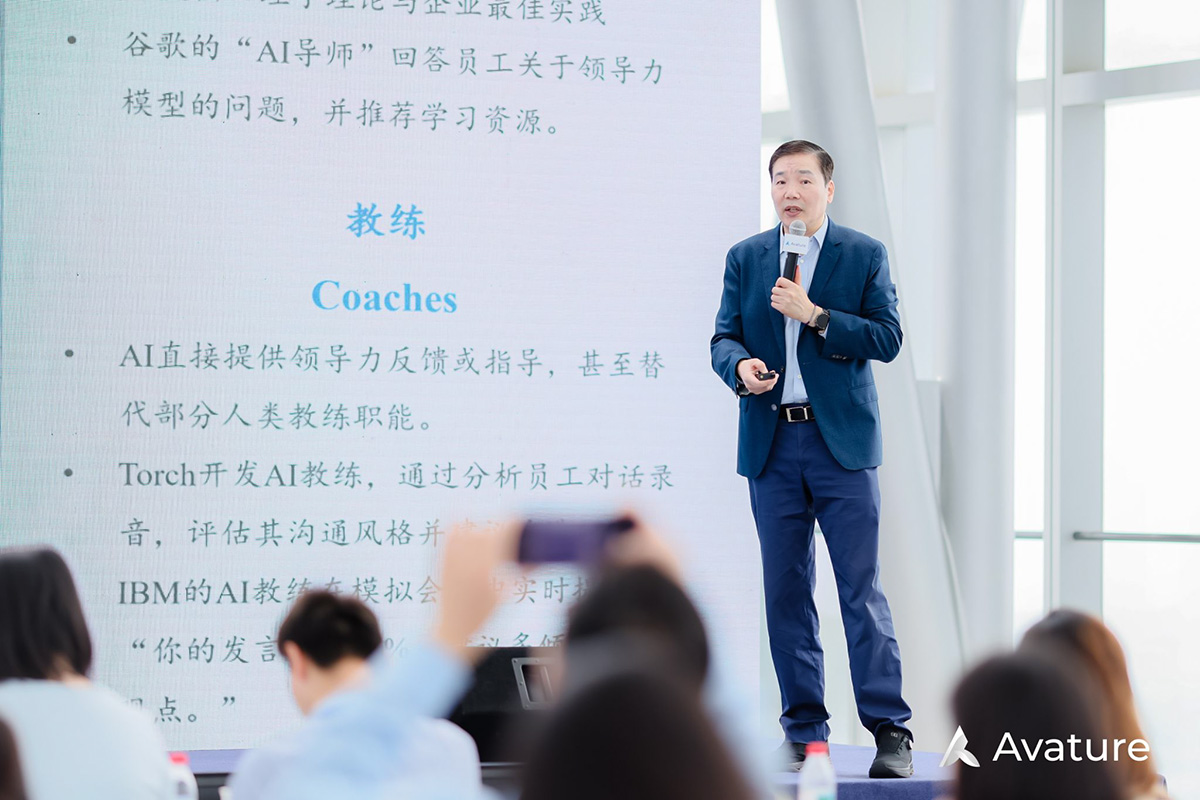
He introduced the ARC leadership model—centered on Agility, Resilience and Connection—which emphasizes that future leaders are not merely users of technology but pioneers of human-machine collaboration. They must quickly enhance their information processing, critical thinking and creative problem-solving skills, integrate resources and drive cultural transformations. Faced with the complex challenges brought by AI, leaders should also serve as challengers, motivators and mentors for their teams, helping individuals find their mission.
In a discussion on human-machine collaboration, Professor Chen referenced an experiment conducted by the University of Cambridge, which involved 344 students and business executives simulating the decision-making process of a car company’s CEO in collaboration with GPT-4o. Supported by complex market data, participants navigated multiple annual decision-making rounds, balancing hundreds of thousands of options while avoiding dismissal by a virtual board and maximizing corporate value.
The results demonstrated that despite AI’s formidable computational power, human decision-makers’ flexible responses and nonlinear thinking offer irreplaceable advantages, especially in balancing and managing sudden challenges, where human creativity and intuition are critical.
Professor Chen concluded that humans’ ability to manage “volatility” and “unpredictability” cannot be replicated by AI. Future leadership must not only preserve human passion and innovation but also leverage AI to enhance their value, forging a new path of symbiosis between humans and machines.
In an AI-driven era, hiring has gained a new dimension: assessing who can better envision the applications of AI. Imagination is not only a manifestation of creativity but also a new dimension in talent selection. Some individuals simply excel in this domain.”
Wayne Chen
Vice Chairman of the CGL Group and CEO of its Management Consulting arm, Professor of Practice at Peking University HSBC Business School
From Recruitment to Activation: How Can TA Reshape Its Value in Talent Mobility?
Steven Chen, Founding Partner of Celeriv Consulting, shared insights garnered from over 25 years in the field of talent management. In the quest for agility and innovation, internal talent mobility has become a crucial lever for organizations to manage uncertainty.
According to research data, within just four years, the proportion of teams handling Talent Acquisition (TA) functions that also manage Talent Management (TM) functions has significantly risen from about 10 to 45 percent. The trend towards integrated talent management is accelerating, and the role of TA is undergoing profound change.
Steven highlighted practical cases from Danaher, Unilever and Schneider Electric, illustrating how leading companies are constructing efficient and agile talent mobility systems through internal talent markets:
- Danaher has established a “free talent market” and created a sustainable mechanism to support employee career development. In this model, the company has achieved a 75 percent internal filling rate for director-level and above positions, with a 55 percent internal mobility target set for specialist roles. By enhancing the visibility of internal talent and job opportunities and simplifying processes, Danaher has significantly reduced attrition rates and enhanced the organization’s overall agility.
- Unilever, through its FLEX internal talent platform, leverages AI technology for skill matching and has successfully freed up 700,000 hours of human resources, increasing overall productivity by 41 percent. The platform has particularly created more cross-departmental development opportunities for female employees (accounting for up to 67 percent). Unilever’s CEO has explicitly stated that this internal talent market has become a crucial factor in driving revenue growth, highlighting the direct contribution of internal mobility to the business.
- Schneider Electric has offered over 55 percent of internal opportunities to female employees through its open talent market, saving up to $15 million in recruitment costs and freeing 550,000 hours of human resources. With AI’s precise matching, employees can receive personalized internal career opportunities in just 15 seconds, helping address nearly half of the employee turnover issues.
![Steven Chen, Founding Partner of Celeriv Consulting, sharing his deep insights from over 25 years in the field of talent management.]](https://www.avature.net/wp-content/uploads/2025/06/Blog-Conference-Recap-China-2025-7.jpg)
While these success stories underline how AI technology can significantly enhance recruitment and talent mobility, Steven also cautioned recruitment teams to be wary of the risks associated with “data bias,” urging them to maintain a reasonable balance between technology and human judgment.
He further noted that the role of TA teams is evolving from mere recruitment executors to “talent brokers,” more deeply involved in talent inventory, career path design and job matching processes. By establishing open and transparent internal talent platforms, companies can effectively unleash the potential of their workforce, enhancing the organization’s responsiveness by being able to quickly reallocate talent based on changing market conditions and needs, and unlocking a true win-win situation for talent and business.
The role of TA is undergoing a fundamental transformation—not just as simple recruitment executors but as key partners in driving talent strategies. Activating internal talent mobility not only unleashes organizational potential but also supports employees in achieving more long-term development.”
Steven Chen
Founding Partner, Celeriv Consulting
AI in Action: Redefining the Future of HR
The conference spotlighted Avature’s cutting-edge product strategies and their real-world applications. The interactive sessions allowed participants to experience AI’s capabilities in talent management and prompted deep reflections on the evolving landscape of HR functions.
Novartis’s Cautious AI Integration in HR
Frank Xu, Head of Talent Acquisition, China at Novartis, shared insights into their cautious yet progressive journey towards integrating AI within their HR processes. Adhering to a principle of “long-term optimism with short-term caution,” Novartis has developed a phased roadmap that aligns closely with its business evolution, methodically advancing the real-world application of AI in managing talent:
- First Phase: Enhancing New Employee Onboarding with AI
The Novartis HR team, in close collaboration with the IT department, launched an “AI onboarding management” tool. Utilizing advanced Large Language Models (LLM), this tool automates the integration of internal policy documents, workflows and training materials, providing real-time Q&A support for new hires. The system also proactively delivers personalized corporate information at various onboarding stages, significantly improving the onboarding experience and ensuring effective transfer of corporate culture and core values. - Second Phase: Thoughtful Application of AI in Talent Assessment
With a cautious approach to talent assessment and recruitment decisions, Novartis has decided against relying solely on AI to make these critical evaluations in the short term. Frank noted that the company prioritizes a “relative fit” over “selecting the best” and that AI does not influence the final decisions during resume screening or interview assessments. This cautious stance also extends to other critical business applications of AI within the company. - Third Phase: Exploring Broader Applications of AI in Talent Management
Looking forward, Novartis is exploring broader applications of AI in talent management. On the one hand, the company aims to utilize AI to develop an intelligent talent pool system that provides real-time insights into external talent market dynamics, helping management accurately identify key talents for critical positions. On the other hand, by aligning with key business transformation milestones, they plan to reverse-engineer the required capabilities and use AI to optimize talent search and communication strategies, preparing well in advance for future organizational development.
Frank also emphasized that because each company’s business rhythm and developmental stage are unique, the pathway and boundaries for AI applications should be customized accordingly. He believes that a robust AI strategy, clear application boundaries and continuous review of practical experiences are essential for realizing the added value of AI in business.
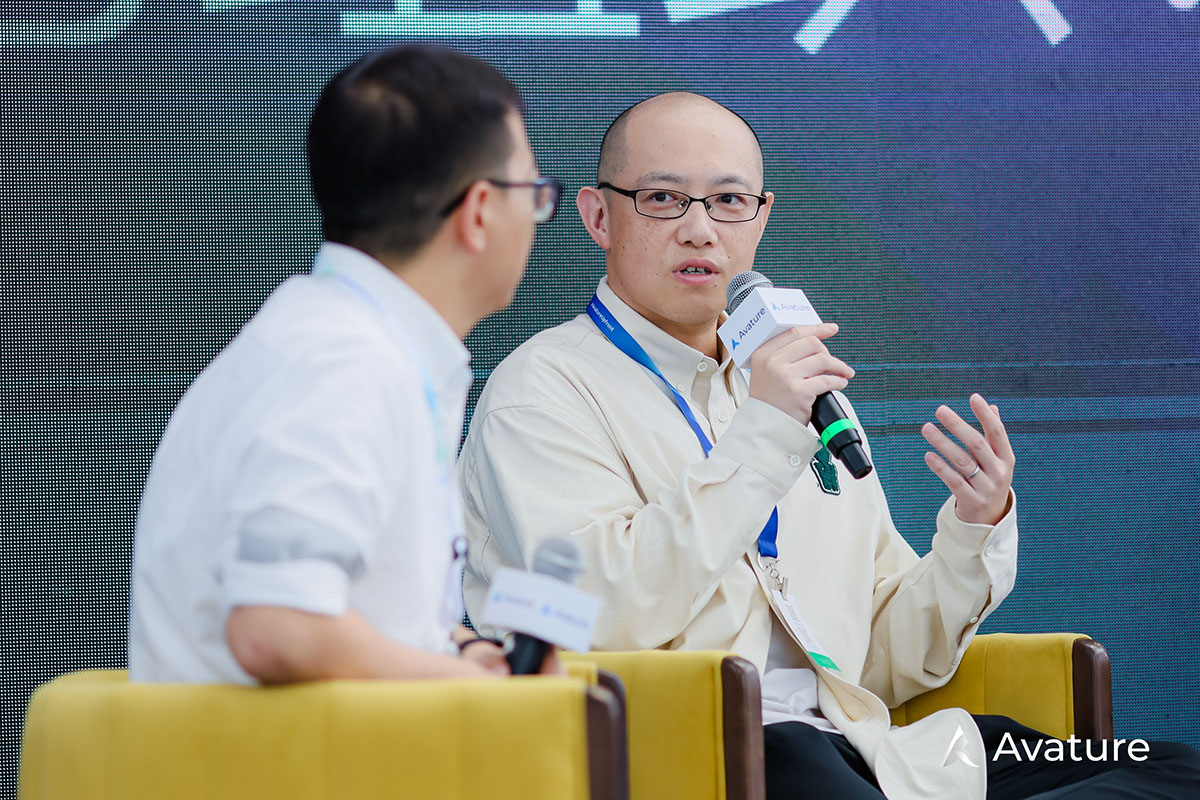
AI Pulse Survey: Interpreting Key Signals in HR Transformation
Beyond the thought-provoking presentations and discussions, the conference featured an engaging, interactive AI game session, where participants experienced innovative AI applications in recruitment and talent management. Concurrently, the AI Pulse Survey fostered live discussions on hot topics such as AI usage during interviews and leadership in AI projects.
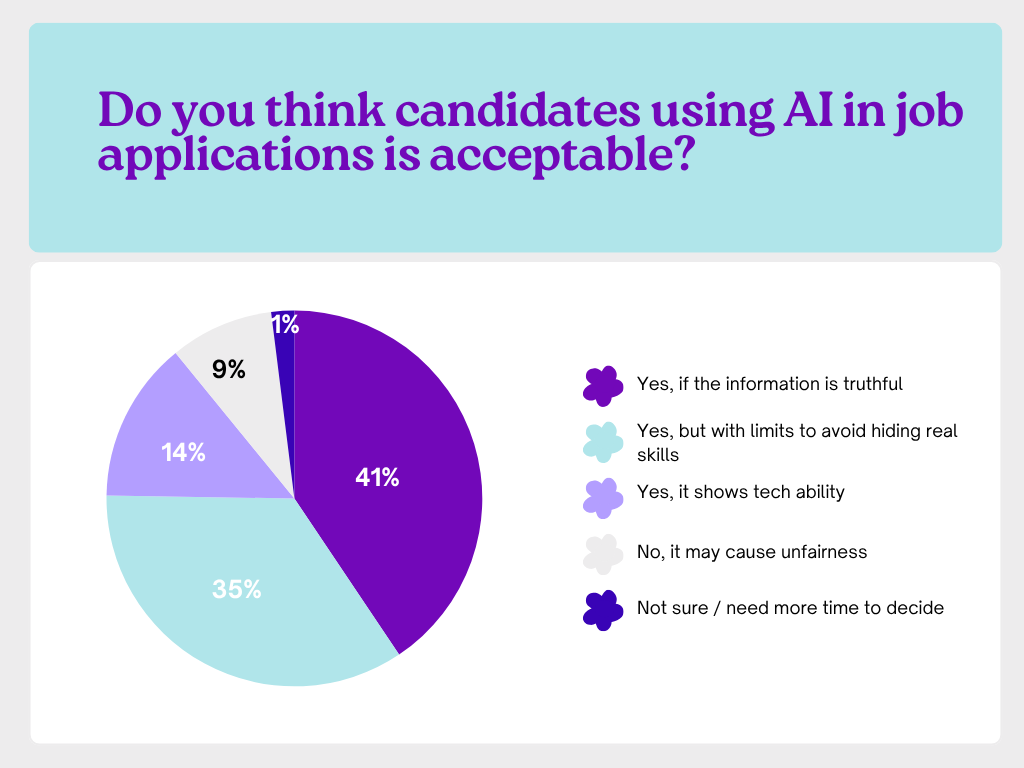
The survey showed that over half of the participants are open to the use of AI by job seekers: 41 percent see no issue as long as the information remains accurate, 14 percent believe that mastering AI is a crucial skill for modern job seekers, and 35 percent support its limited use, emphasizing the importance of not obscuring genuine skills. The low percentage of opposition or doubt highlights AI’s growing acceptance as a powerful tool in recruitment.
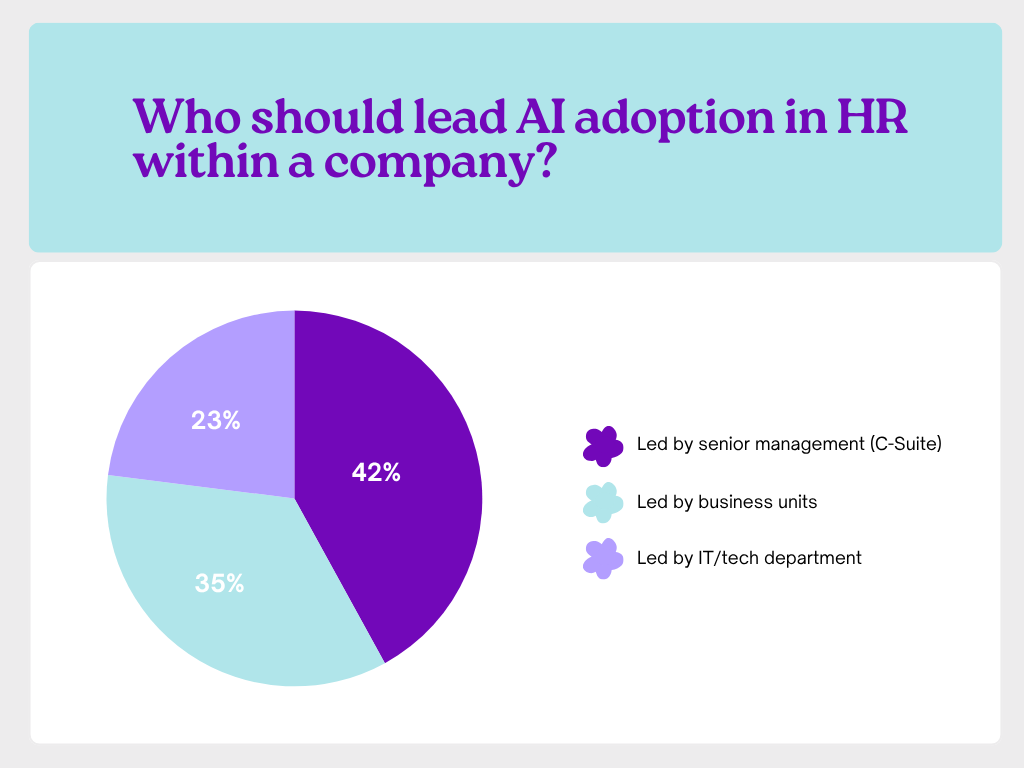
Regarding leadership in AI applications, 42 percent of survey respondents believe it should be driven by top management, 35 percent support the leadership of business departments and 23 percent see the tech department playing a significant role.
The results suggest that the effective promotion of AI requires strong collaboration across departments and solid upper management support, with no single area able to achieve optimal outcomes alone. At the conference, speakers shared how some manufacturing and tech firms now include AI-driven recruitment in HR performance reviews—led by business units and supported by tech teams—to ensure successful adoption and ongoing optimization.
![Survey results displayed: "In which of the following areas do you think AI has the greatest impact?"]](https://www.avature.net/wp-content/uploads/2025/06/Blog-Conference-Recap-China-2025-13-2.png)
In the survey section “Most AI-focused areas in the recruitment process,” resume screening and assessment led with 58 percent support, followed by automated job description generation at 47 percent and scheduling interviews at 44 percent. Clearly, AI is significantly enhancing recruitment efficiency at these key stages, saving considerable time and costs.
This interactive experience not only deepened participants’ understanding of AI’s practical applications in HR management but also spurred thoughtful discussions on how HR can play a more strategic role in the intelligent transformation of organizations.
Inside Avature’s AI Roadmap: Innovation in Action
Xiaobin Shi, Avature Sales Engineering and Product Marketing Manager in China, unveiled the upcoming developments in Avature’s roadmap, starting with the soon-to-be-released Avature Copilot. This innovative product, powered by agentic AI, will assist users across various tasks, from drafting job descriptions and filtering candidates to designing web portals and creating interview questions, offering comprehensive intelligent support. In addition to Copilot, Xiaobin spoke about other upcoming AI developments in matching, search and our chatbot and explored how the explainability trait of Avature AI enables more informed and confident decision-making.
As he continued to explore our roadmap, he also showcased tools designed to increase autonomy and enterprise agility, including the configuration manager and enhancements to our scheduling and data management capabilities, among others. He closed the presentation by underlining a key point: real agility comes from a platform that combines configurability, autonomy and explainable AI. That’s what enables organizations to adapt faster and build a sustainable competitive advantage.
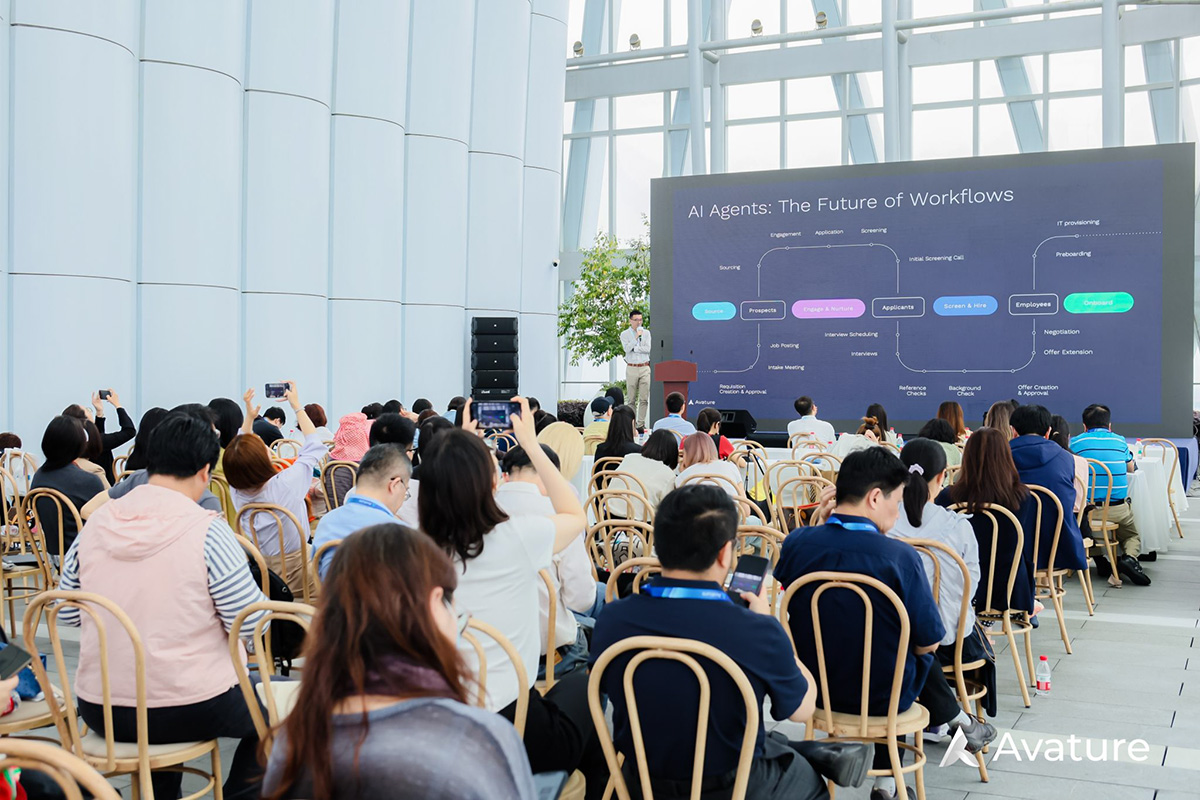
This roadmap isn’t built in isolation — in fact, 70 to 80 percent of Avature’s new functionalities are driven by customer feedback. By combining these insights with industry trends and cutting-edge research, Avature ensures its innovation efforts stay grounded in real-world needs. This customer-centric approach fuels a continuous feedback loop that helps the platform evolve in sync with the challenges organizations face in recruiting and talent management, from digital transformation to the implementation of high-impact strategies.
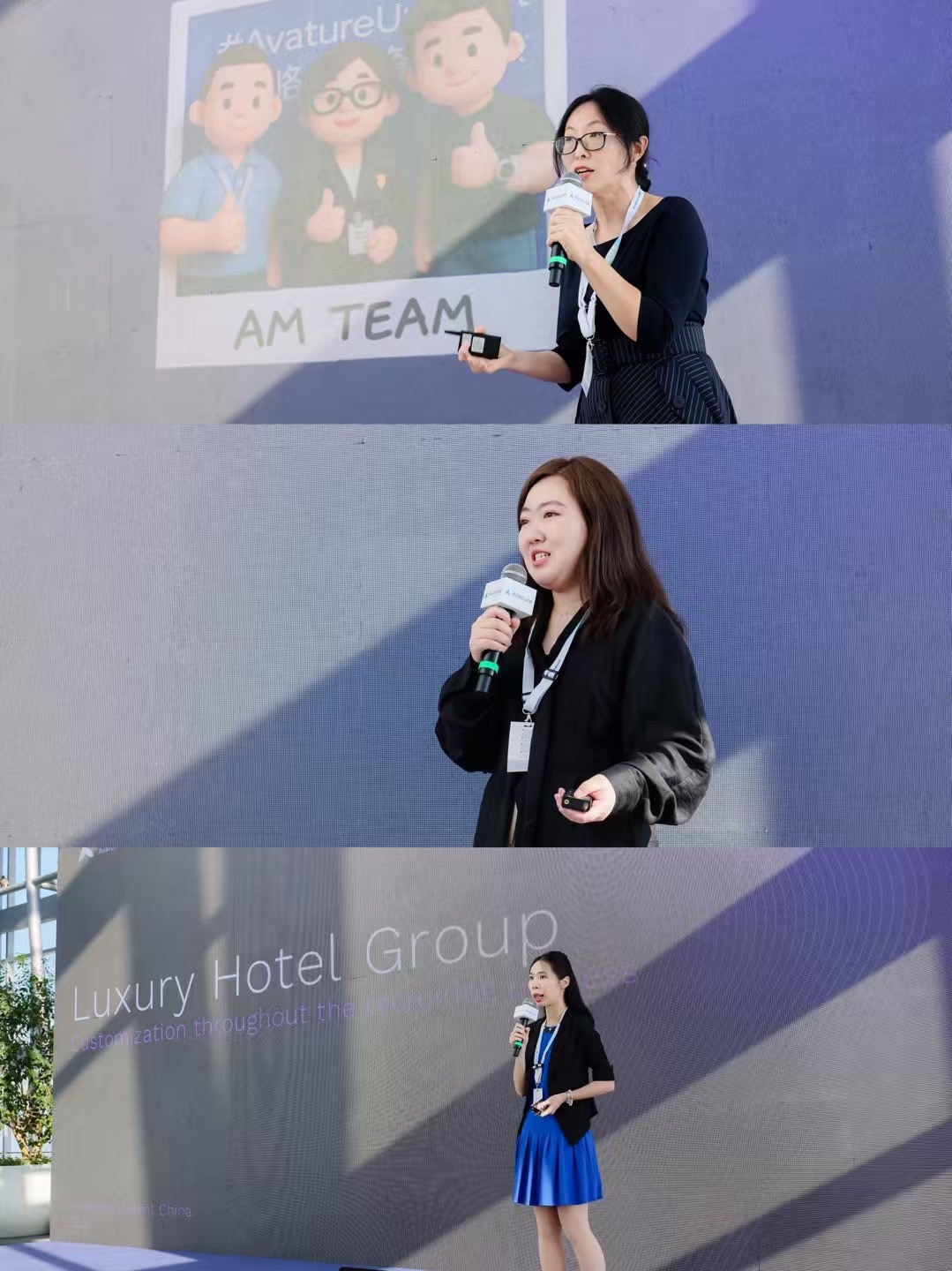
Practical innovation was also at the heart of the “Art of the Possible” session, where Avature system experts showed how the developments in our product roadmap help shape a highly configurable and adaptable platform. Through real-world case studies, they illustrated how organizations are using Avature creatively, well beyond traditional recruitment and talent management. These stories served as powerful examples of how the platform’s flexibility can drive meaningful outcomes across the entire business.
Thank you once again to all attendees for their active participation and lively interaction! We look forward to reconnecting in the future to explore further possibilities in HR management.
![Avature staff posing for a group photo after the #AvatureUpfront China 2025 conference.]](https://www.avature.net/wp-content/uploads/2025/06/Blog-Conference-Recap-China-2025-14.jpg)


